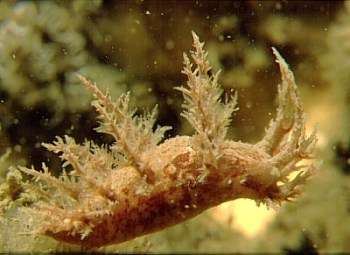
Dendronotus frondosus
(Ascanius, 1774)
Order: NUDIBRANCHIA
Suborder: DENDRONOTINA
Family: Dendronotidae
DISTRIBUTION
Boreo-Arctic. In North Atlantic as far south as France (on European coast), and New Jersey (in North America). In North Pacific as far south as Los Angeles, California.
PHOTO
Zeelandbrug, Zierikzee, Oosterschelde, The Netherlands, 20 May 1999. PHOTO: Peter H. van Bragt.
Grows to about 100mm. Juvenile animals feed on calyptoblastic hydroids such as Sertularia cupressina & Dynamena pumila while adults feed on the gymnoblastic hydroids of the genus Tubularia. The quite unrelated Indo-West Pacific aeolid Pteraeolidia ianthina has an identical change in diet from small colonial calyptoblastic hydroids to larger gymnoblastic tubularians.
Taxonomically confused 'species'. Robilliard (1975) discusses the probability of at least 4 ecologically distinct species in NE Pacific.
Reference:
• Thompson, T.E. & Brown, G.H. (1984) Biology of Opisthobranch Molluscs, Vol 2. Ray Society: London.
• Robilliard, G.A. (1970) The systematics and some aspects of the ecology of the genus Dendronotus (Gastropoda: Nudibranchia). The Veliger, 12(4): 433-479.
• Robilliard, G. A. 1975. The nudibranch Dendronotus frondosus - one species or four? The Festivus (San Diego Shell Club), 6(8): 44-47.
Related messages
Re: Dendronotus dalli from Alaska
February 19, 2008
From: Marianne Lawrence
Concerning message #7682:
I was diving at La Jolla Shores in San Diego, CA last week on a night dive. Unfortunately I did not have a camera and I could not get the attention of my dive buddies as I saw a nudibranch I could not identify. I have seen many varieties but nothing of this type. I thought it must be a variety of Dendronotus frondosus because it was a light brown color but it just didn't look like the many others I have seen before. It looked just like the Dendrontus dalli picture but it was a tan/light brown color with tiny white spots all over it. Any idea what it could be? The Dendrontus dalli isn't supposed to be this far south.
Marianne
mml712001@yahoo.com
Lawrence, M., 2008 (Feb 19) Re: Dendronotus dalli from Alaska. [Message in] Sea Slug Forum. Australian Museum, Sydney. Available from http://www.seaslugforum.net/find/21331Hi Marianne,
You are correct, San Diego is much to far south for the cold temperate Dendronotus dalli. I am quite sure you saw one of the many color variations of D. frondosus. I have received a number of photos of specimens similar your description recently from the San Diego gang.
Here is a little hint for the next time you see these guys. The surface of the body in Dendronotus dalli is smooth with no specks, whereas the skin texture of D. frondosus is bumpy, almost tuberculate, and covered with specks.
Good luck,
Dave Behrens
Re: Dendronotus frondosus? from British Columbia
September 24, 2007
From: Jackie Hildering & Louisa Bates
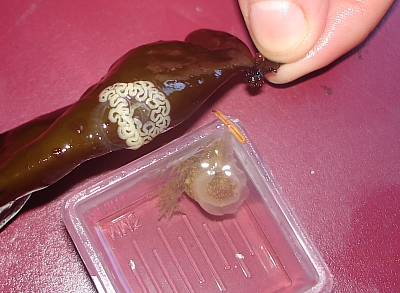
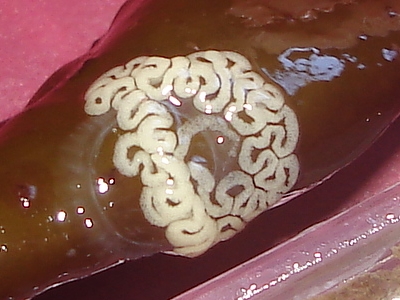
Hello Bill,
This "find" was the result of seaweed being collected for addition to a marine tank at the Whale Intepretive Centre in Telegraph Cove. I believe it to be Dendronotus frondosus.
The interpreter at the Centre, Louisa Bates, noticed the nudibranch on the seasac on August 15th at the surface of the tank. She believes it may have been accidently brought into the tank around August 13th when they collected seaweed in the intertidal zone.
Locality: Telegraph Cove, 0 feet, British Columbia, Canada, Pacific Ocean, 15 August 2007, In a marine aquarium . Length: +/- 4 cm. Photographer: Jackie Hildering.
She observed the animal next to the egg mass on the sea sac and recalls that there was nothing on the seasac when she collected it for the tank. So . . . some possibility they are the mass of D. frondosus seen it is highly unlikely any other nudibranchs were in the tank.
Since I did not have my underwater camera with me, we quickly photographed the animal and the mass as you see them in the photo, prior to releasing them.
Hope it is of interest.
Jackie Hildering
earthlingenterprises@telus.net
Bates, L. & Hildering, J., 2007 (Sep 24) Re: Dendronotus frondosus? from British Columbia. [Message in] Sea Slug Forum. Australian Museum, Sydney. Available from http://www.seaslugforum.net/find/20516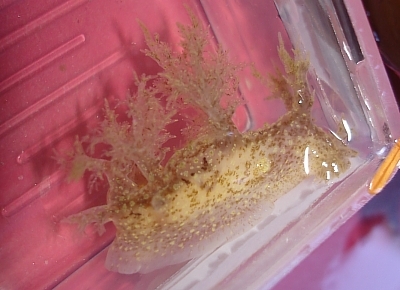
Hi Jackie and Louisa,
Well, not only is it pretty obvious who the eggs belong to, but the eggs do look like those of D. frondosus which is what your critter certainly is.
Thanks for sharing,
Dave Behrens
Dendronotus frondosus and eggs
September 11, 2007
From: Kevin Lee
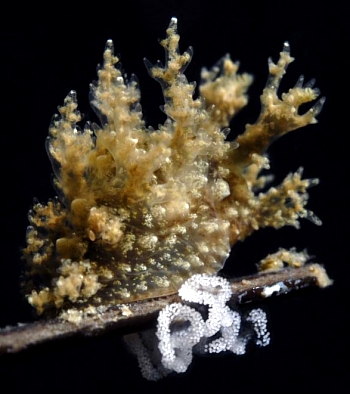
Re message #20523
Here is another Dendronotus frondosus for the forum collection. This one is by its egg ribbon
Locality: La Jolla, California, USA. Length: 1.5 cm. Depth: 65 fsw, detritus field 12 May 2007. Photo: Kevin Lee
Best regards,
K:-)
diverkevin@gmail.com
Lee, K., 2007 (Sep 11) Dendronotus frondosus and eggs. [Message in] Sea Slug Forum. Australian Museum, Sydney. Available from http://www.seaslugforum.net/find/20599Hi Kevin,
This specimen is quite covered with multi-fid tubercles, and the gill tufts are really branched. Great to record its eggs.
Thanks,
Dave Behrens
Dendronotus frondosus from California
September 11, 2007
From: Kevin Lee
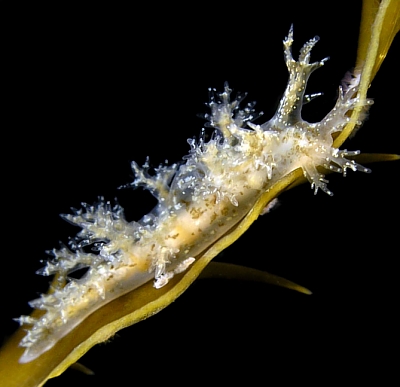
Would like to contribute some Dendronotus frondosus to the forum collection. I note there seems to be a wide variety of frondosus shape and color. However, being the same species, can all of them mate with each other?
Locality: Upper photos: La Jolla, 60fsw, California, USA, Eastern Pacific, 10 FEB 2007, detritus bottom. Length: 1.5 cm.Lower Photo: 21 DEC 2006; 45fsw; Redondo Canyon, California. Photographer: Kevin Lee.
Best regards,
K:-)
diverkevin@gmail.com
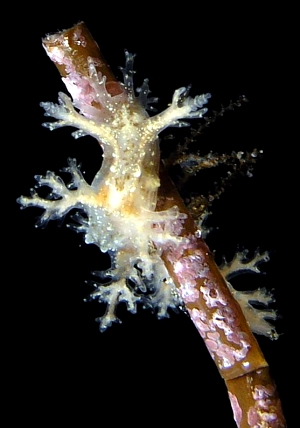
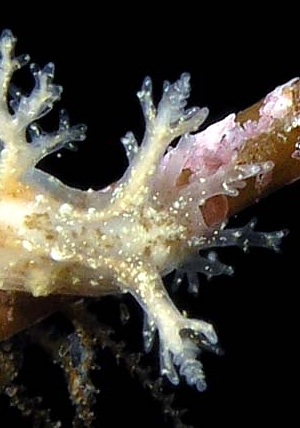
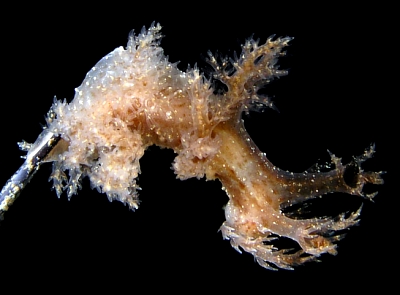
Hi Kevin,
Great photos. Yes, this species demonstrates wide variability in coloration. Your photos hear show the details that distinguish it from other dendronotids - branched projections on the frontal veil, low tubercles on body and a branch on the rhinophoral shaft.
Thanks for sharing,
Dave Behrens
Dendronotus frondosus from Monterey, California
June 11, 2007
From: Clinton Bauder
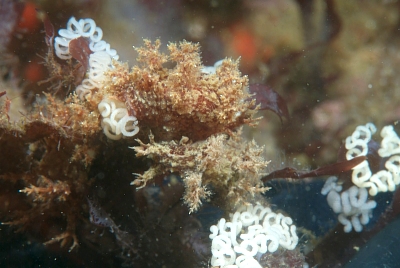
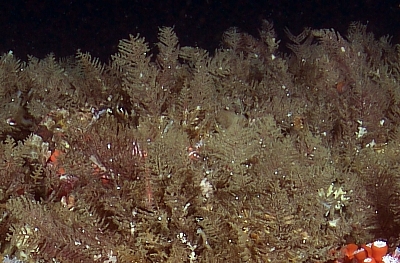
Concerning message #17107:
Hi Bill and Dave,
Another one from Alicia's visit, this one a more common species. While there are lots of entries on the forum for this highly variable species, Dendronotus frondosus, none quite look like these especially fuzzy examples. Plus, this picture shows the egg mass.
Locality: Monterey, 15 meters, CA, USA, Pacific, 20 May 2007, Shale Beds off of Del Monte Beach. Length: 20mm. Photographer: Clinton Bauder.
Sadly the pictures I got don't show the hydroids these animals were on so I've included another shot from a little less than a year ago of the same site which shows the hydroid. Interestingly this hydroid normally doesn't seem to have much living on it but during Alicia's visit it was loaded with Dendronotus frondosus and Hancockia californica.
Cheers,
Clinton
gecko1@apple.com
Bauder, C., 2007 (Jun 11) Dendronotus frondosus from Monterey, California. [Message in] Sea Slug Forum. Australian Museum, Sydney. Available from http://www.seaslugforum.net/find/19969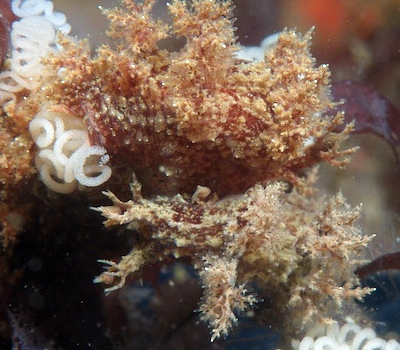
Dear Clinton,
Often wonder why well camouflaged animals like these give themselves away by laying such blindingly obvious egg masses. I guess by the time they produce egg masses their evolutionary duty is done
Best wishes,
Bill Rudman
Dendronotus frondosus from Portland, UK
July 25, 2006
From: Etienne Lorrain
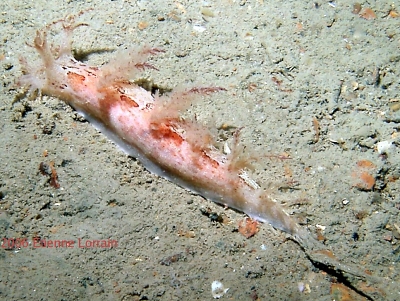
While diving a 45 meters under a wreck near Portland, south coast of United Kingdom - I saw this unusual animal - which I thought was worth a photo.
At this depth, it is getting difficult to be perfectly in focus ... other than the obvious in the photo, I did notice a strong "trace" trailing from where it is coming from: in fact I thought at first it was a plastic lure with a fish-hook, still attached to a fishing line.
Locality: Salsette wreck, 45 meters, England, English channel, June 2006, muddy bottom, under wreck overhang. Length: 2 to 3 inches. Photographer: Etienne Lorrain.
Etienne Lorrain
etienne_lorrain@yahoo.fr
Etienne Lorrain, 2006 (Jul 25) Dendronotus frondosus from Portland, UK. [Message in] Sea Slug Forum. Australian Museum, Sydney. Available from http://www.seaslugforum.net/find/17107Dear Etienne,
This is Dendronotus frondosus. This species is found on both sides of the nthn Atlantic and also from the west coast of Nth America. There is some discussion about whether it is all one species, but I suspect a lot of ecological and anatomical work will need to be done before that question is resolved.
Best wishes,
Bill Rudman
Re: Dendronotus subramosus from Monterey, CA
September 15, 2005
From: Dave Behrens
Bill:
Concerning message #14245:
Too bad we cannot see the processes on the side of the head (that would be very helpful), and the cerata do not look "palmate" at all to me.
Because of the nodulose surface of the rhinophores (which in Hancockia are very smooth, and grooved), and same surface on the cerata, I have to call this species - Dendronotus frondosus.
Some variable critters just can't be ID'd from photos, no matter how great the photo.
Dave Behrens
dave@seachallengers.com
Behrens, D., 2005 (Sep 15) Re: Dendronotus subramosus from Monterey, CA. [Message in] Sea Slug Forum. Australian Museum, Sydney. Available from http://www.seaslugforum.net/find/14770Thanks Dave,
Nice to clear that up
Best wishes,
Bill Rudman
Dendronotus subramosus from Monterey, CA
September 9, 2005
From: Clinton Bauder
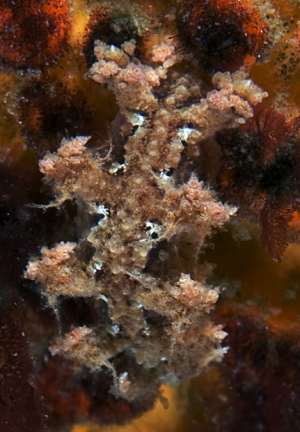
Hi Bill,
I think this one is Dendronotus subramosus with a possible food hydroid all living on the puffball sponge Tethya aurantia. The location was quite fortuitous as it provided the necessary contrast for me to see this rather cryptic beast. Size was about 10mm and depth about 18 meters on the Shale Beds off of Del Monte Beach. The picture was taken by my friend Mike Jimenez.
Locality: Monterey, California, USA. Depth: 18 meters. Length: 10 mm. 8 July 2005. Shale. Photographer: Mike Jimenez
Clinton
gecko1@apple.com
Bauder, C., 2005 (Sep 9) Dendronotus subramosus from Monterey, CA. [Message in] Sea Slug Forum. Australian Museum, Sydney. Available from http://www.seaslugforum.net/find/14245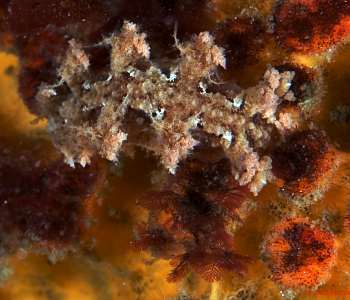
Thanks Clinton,
I will be interested in some expert opinion. I understand that this is a very variably coloured species, but I don't know if this falls within the variability. I can't see any hydroids in your photo. Dendronotus subramosus is reported to feed on the feathery hydroid Aglaophenia
Best wishes,
Bill Rudman
Bushy-backed Sea Slug behaviour
July 20, 2005
From: Herb Segars
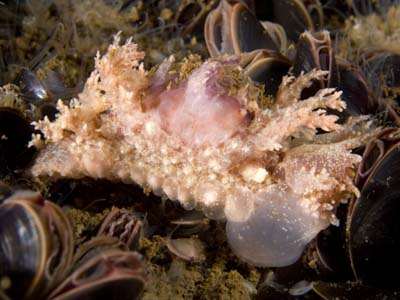
I photographed this bushy-backed sea slug on an artificial reef site off New Jersey. I was curious about the bubble-like appendages on the topside and the underside of the sea slug. Can anyone tell me what they are?
Locality: Axel Carlson Artificial Reef, site Veronica M, New Jersey, USA
Atlantic Ocean. Depth: 65 feet. Length: 2.5 inches. 15 July 2005. artificial reef tugboat deck, on blue mussels. Photographer: Herb Segars
Herb Segars
hsegars@gotosnapshot.com
Segars, Herb, 2005 (Jul 20) Bushy-backed Sea Slug behaviour. [Message in] Sea Slug Forum. Australian Museum, Sydney. Available from http://www.seaslugforum.net/find/14280Dear Herb,
I guess this is Dendronotus frondosus but as yu will see on the Dendronotus cf frondosus page, there is stll some puzzles concerning the identity of these animals on the Atlantic coast of Nth Americal. The swollen whitish bit on the top of the animal is in the region of the heart and it seems as though the animal may be a bit damaged. The 'bubble' at the front end - underneath - loos like the oral tube everted out from the mouth. It could be a healthy activity - everted for feeding - or it could be another sign of a problem. These animals when 'sick' often evert the foregut and if parts of the body wall become damaged, parts of the viscera push out throught the weakened part of the body. I don't know if that is what is happening here, but I assume it is an unusual sight for you, so it is the most likely answer.
Best wishes,
Bill Rudman
Re: Dendronotus frondosus? from Norway
February 9, 2003
From: Kåre Telnes
Dear Bill,
Thanks for your comments. The slug was photographed on 31 January 2003 and was approximately 20 mm long.
Best wishes,
Kåre Telnes
kaare.telnes@online.no
Re: Dendronotus frondosus? from Norway
February 9, 2003
From: Jussi Evertsen
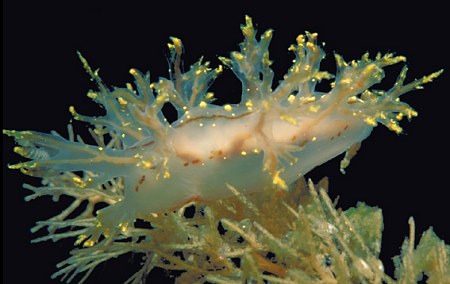
Dear Bill,
Concerning your reply to Kåre's message. I have no other comment than agreeing on this being a Dendronotus, possibly a juvenile D. frondosus by its transparency and vivid colouration.
I have attached a photo taken at Galgeneset in the Trondheim fjord from April 1999 (depth 12 m), the specimen is 15 mm. I have observed similar individuals later, but the funny thing is that I have only seen them from this locality.
At this time of year Dendronotus frondosus usually occur in great numbers spawning all over in the Trondheim fjord.
Jussi
jussi.evertsen@vm.ntnu.no
Evertsen, J., 2003 (Feb 9) Re: Dendronotus frondosus? from Norway. [Message in] Sea Slug Forum. Australian Museum, Sydney. Available from http://www.seaslugforum.net/find/9157Thanks Jussi,
This is almost identical in colouration to Kåre's animal, except in yours there is a median brown line as well.
Bill Rudman
Re: Dendronotus frondosus? from Norway
February 9, 2003
From: Alan Shepard
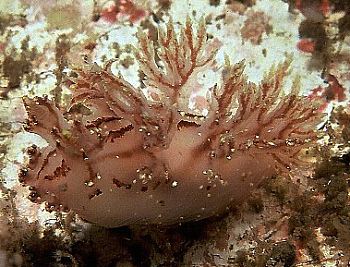
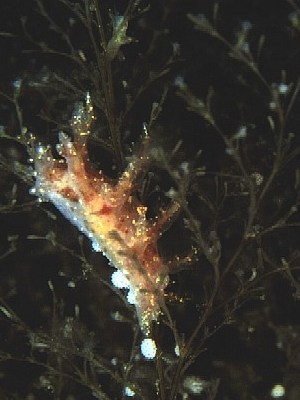
Bill -
I was interested in the post concerning the Dendronotus frondosus from Norway. The coloration is much like a nudibranch I photographed on the wreck of the HMCS Saguenay off Lunenburg, Nova Scotia [Canada, Atlantic coast]. Like the photo from Norway you can clearly see the digestive gland duct clearly going in to the cerata. However there is no gold speckling. This nudibranch was about 25mm, but it had contracted a bit so it may have been a bit larger. The depth was about 20m.
I am also attaching another photo taken on the wreck of D. frondosus with the gold speckling. Most of the D. frondosus on the wreck, and there were plenty of them, had the gold speckling. I'm not sure whose eggs those are on the hydroids.
Alan Shepard
Tolland, CT
alan.chepard@snet.net
Shepard, A., 2003 (Feb 9) Re: Dendronotus frondosus? from Norway. [Message in] Sea Slug Forum. Australian Museum, Sydney. Available from http://www.seaslugforum.net/find/9161Thanks Alan,
Bill Rudman
Dendronotus frondosus? from Norway
February 4, 2003
From: Kåre Telnes
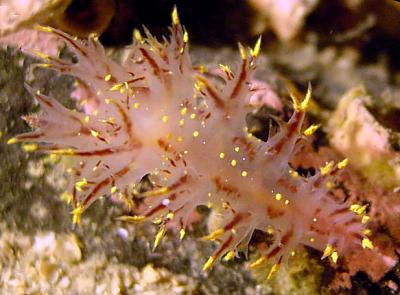
Hi!
I found this sea slug at 26 meters depth in the Trondheim fjord, at the coast of Norway. I have not seen this species before, and cannot find it in my literature. Looks like some sort of Flabellina, but I am not sure. Does anyone know?
Kåre Telnes
kaare.telnes@online.no
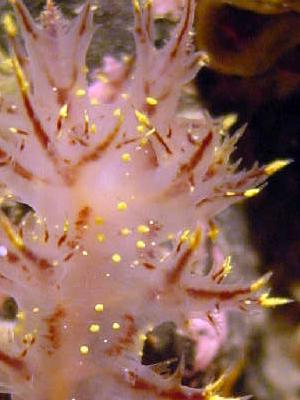
Dear Kåre,
Your animal is a species of Dendronotus, and I suspect it is a colour form of D. frondosus. Perhaps it is a juvenile - unfortunately you don't give me any idea as to its size. In juveniles, the digestive gland duct goes up into the 'cerata' and the rhinophore stalks, which is definitely the case in your photo. See Jussi Evertsen's message describing 'goldspeckled juveniles' from Norway.
Hopefully one of my European colleagues can confirm my identification or suggest a better one
Best wishes,
Bill Rudman
Re: white Dendronotus frondosus
November 4, 2002
From: Jim Anderson
Dear Bill,
This may or may not be relevant, but are you aware of the paper by Mikael Tholleson [mikael.thollesson@ebc.uu.se].
• Tholleson, M. (1998) Discrimination of two Dendronotus species by allozyme electrophoresis and the reinstatement of Dendronotus lacteus (Thompson, 1840). Zoologica Scripta, 27(3): 189-195.
Kind regards,
Jim Anderson
JAnder4454@aol.com
Anderson, J., 2002 (Nov 4) Re: white Dendronotus frondosus. [Message in] Sea Slug Forum. Australian Museum, Sydney. Available from http://www.seaslugforum.net/find/8352Dear Jim,
Sometimes papers slip past me. I found the following summary of Mikael's project on the Malacological Society of London's website. It certainly does seem relevant, and further illustrates that we still have a lot to learn about these animals.
"Dendronotus frondosus (Ascanius, 1774) is a boreal nudibranch which appears in several colour variations. Some of these forms seem to be more distinct and the question is whether these are better regarded as separate species. In particular, I found some specimens on the Swedish West Coast that had an opaque white colour with dark purple-blackish blotches; the common Dendronotus here is brownish. As I had specimens of both colorations from the same locality, the biological species concept could be applied and tested using allozyme electrophoresis. Allozyme electrophoresis makes it possible to score the genotype as well as the alleles carried by each specimen. Under the null hypothesis that only one population is present in the sample, the genotype frequencies are expected to follow Hardy-Weinberg frequencies. That is, if we have two alleles at a particular locus with frequencies p and q (as counted from the electrophoretic analysis), the two homozygotes should be present in frequencies p2 and q2 respectively, and we should have a frequency of 2pq heterozygotes.
In the Dendronotus study, I found four loci where one allele was present in 100% of the brown specimens (i.e. all homozygotes) and another allele in 100% of the white specimens (all homozygotes for the other allele). Thus p = q = 0.5, and we expect that half of the specimens should be heterozygotes, yet none was found. As this pattern was repeated for four independent loci (Mpi, Mdh, Idh and Acp), this is strong evidence against the specimens coming from one population. Since the specimens came from dredge hauls at the same locality, they can be considered to be different species according to the biological species concept.
As this was further supported by morphological differences, I reinstated the name Dendronotus lacteus (Thompson, 1840) for the white specimens. What we should call D. frondosus remains another topic ..."
.. Tholleson, M., 1999(August) Nudibranch systematics and molecular data. [In] Bulletin of the Malacological Society of London, 33. http://socrates.edsc.ulst.ac.uk/bull/Bull33/b33.html.
Thanks,
Bill Rudman
White Dendronotus frondosus from Canada
November 2, 2002
From: Bill Rudman
Some time ago Marli Wakeling sent a photo of a small white Dendronotus which I first considered a small D. diversicolor and later as Dendronotus cf. dalli. While preparing today's message on swimming Dendronotus I checked Gordon Robilliard's (1970) review of the genus and saw his photo of the white form of D. frondosus which is almost certainly the same as the animal in Marli's photo. Robilliard, in a later WSM/AMU symposium, (1975) reports on his investigation of the ecology of D. frondosus in Washington State. He was convinced, by the quite distinct ecological separation in terms of food and habitat, that there were a number of species involved. To my knowledge this has never been further investigated.
Reference:
• Robilliard, G. A. 1975. The nudibranch Dendronotus frondosus - one species or four? The Festivus (San Diego Shell Club), 6(8): 44-47.
Best wishes,
Bill Rudman
Dendronotus frondosus? from British Columbia
June 18, 2002
From: Marli Wakeling
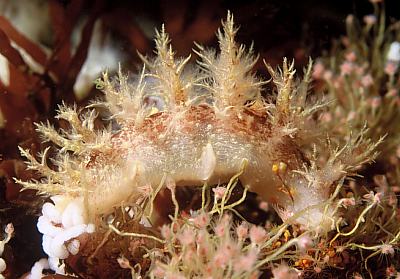
Hi Bill,
We found this animal whilst diving in the Broughton Archipelago. I had on a small framer, so a friend took the picture. I have never seen a specimen of this size, (usually 5mm and not entirely positive about the I.D.) and never so bushy. The thing that struck us all were the strange yellow-orange spikes down its back: you can make out several in the photo, but not as clearly as we all saw them. We all agreed they looked like traffic cones! The colour appeared flourescent orange without light. I discussed the photo with Dave Behrens, and although it looks like a Dendronotus frondosus, the spikes are an anomaly to the species. It was eating Garveia annulata, a bright orange hydroid, and Tubularia crocea, a pink hydroid. The following week,just north of the area, one of the divers saw another one which was smaller but had the spikes, but alas, no photo.
Dive Site: Marg's Wall, Broughton Archipelago, British Columbia, Canada
Depth: 65 feet
Length: 3 inches
Date: May 19, 2002
Photo: Dave Twitchet
Marli
scubamarli@excite.com
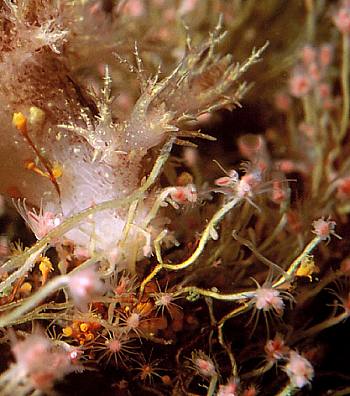
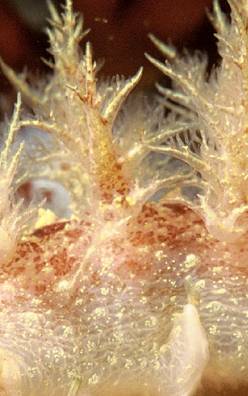
Thanks Marli,
Perhaps the bright yellow cones are papillae that have taken up some of the bright yellow pigment from Garveia annulata? I can't say anything sensible about species ID so I would welcome any comments from out northern hemisphere colleagues,
Best wishes,
Bill Rudman
Tiny Dendronotus from southern Maine
June 29, 2001
From: Paul Young
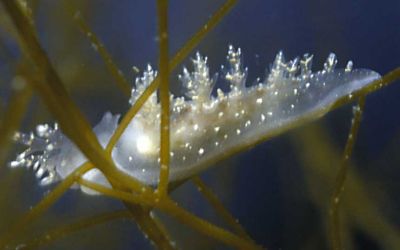
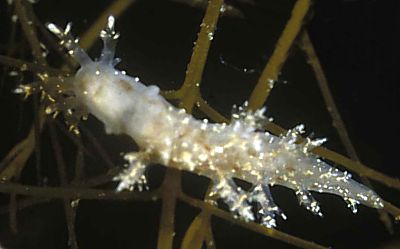
This small (under 1 cm) animal was at a depth of about 10m. It may be a juvenile D. frondosus.
This one was photographed by my wife, Charlotte Richardson.
Note: the blue background is part of my wetsuit; it is very rare for New England water to be blue! Particularly during the spring plankton season, our water is a beautiful green.
Paul Young
young@underwater.org
Young, P., 2001 (Jun 29) Tiny Dendronotus from southern Maine. [Message in] Sea Slug Forum. Australian Museum, Sydney. Available from http://www.seaslugforum.net/find/4677Note added 30 Jan 2002: See Chad Sisson's message identifying this as D. frondosus.
Dear Paul,
I am following the suggestion in Jussi Evertsen's message and considering all your photos as being of the same variable species Dendronotus frondosus. Jussi shows two extremes of the colour variation in northern Europe. In case we're wrong, I'll keep them on a separate page as Dendronotus cf. frondosus. I suspect this will not be resolved until someone has a closer look at your east coast fauna.
Best wishes,
Bill Rudman
Re: New England Dendronotus
June 29, 2001
From: Jussi Evertsen
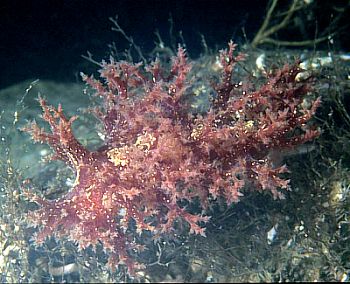
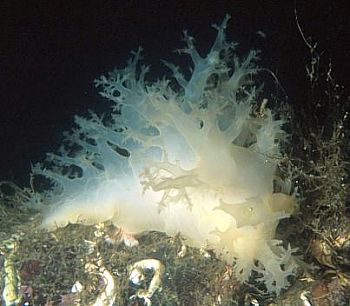
Dear Bill and Paul Young
From the pictures given in Paul's message, I also agree that it cannot be a D. robustus. D. robustus has a extremly well developed velum (See: G. O. Sars 1878, tab. 28 - as D. velifer for a good drawing), and my own observations on the species are from muddy localities from Spitsbergen. Unfortunately I do not have any good photos of the species, since my frames when photographying in situ have been too small! I have though attached two pictures of D. frondosus, one brown speckled and one all white, both types quite common in Norwegian fjords, both animals found at shallow depths here at the Biological Station in Trondheim measuring approximately 8 cm in length. Other observations on D. frondosus have shown a great variety in colour, from all black to sulphur yellow, to the most extreme gold speckled juvenile forms. So as to the colour, it does vary a great deal, and from both the pictures of Paul Young [message 1, message 2] I would from own experience regard them more related to D. frondosus.
I hope this is of some use.
Yours sincerely
Jussi Evertsen
jussie@stud.ntnu.no
Evertsen, J., 2001 (Jun 29) Re: New England Dendronotus. [Message in] Sea Slug Forum. Australian Museum, Sydney. Available from http://www.seaslugforum.net/find/4680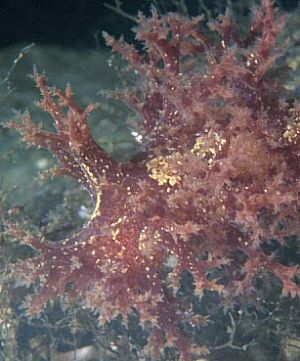
Dear Jussi,
This is exactly the information we need - some field observations of living animals from someone who knows the species. Unless someone disagrees I think I'll move both of Paul's 'species' to a Dendronotus cf. frondosus page.
The yellow spots on your reddish-brown animal ceratainly suggest a link to the spots in Paul's photos.
Best wishes,
Bill Rudman
Dendronotus sp? from New England
June 24, 2001
From: Paul Young
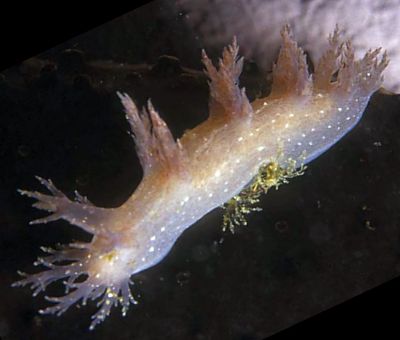
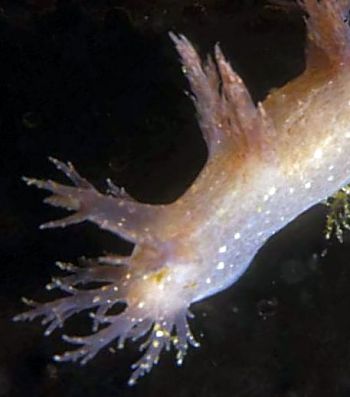
Locally these are called Bushy-Back Nudibranches. We think there are two species here. The heavier set animal in the other message we think is Dendronotus robustus.
The more elongated animal here we think is Dendronotus frondosus
They are common in central Maine [USA - Atlantic coast]. They are about 4 cm long and are usually found on kelp. These were photographed off Mount Desert Island.
Paul Young.
young@underwater.org
Young, P., 2001 (Jun 24) Dendronotus sp? from New England. [Message in] Sea Slug Forum. Australian Museum, Sydney. Available from http://www.seaslugforum.net/find/4621Note added 30 Jan 2002: See Chad Sisson's message identifying this as D. frondosus.
Dear Paul,
Despite reading the literature on this genus, I give up. Can anyone help to identify these animals? Are they all colour forms of D. frondosus?
Best wishes,
Bill Rudman
Re: Dendronotus frondosus size
October 31, 2000
From: Marli Wakeling
Hi Bill,
Well to me tiny is below 1 cm. These little guys were taken with a 1:1 framer, and then cropped considerably; my estimate is about 5mm, as on an earlier shot, I fit 4 on one frame. I'm beginning to think a lot of species don't grow as large in our chilly waters, as I seem to find only the puny ones!
Marli Wakeling
scubamarli@excite.com
Wakeling, M., 2000 (Oct 31) Re: Dendronotus frondosus size. [Message in] Sea Slug Forum. Australian Museum, Sydney. Available from http://www.seaslugforum.net/find/3265Thanks Marli,
Bill Rudman.
Dendronotus frondosus from Canada
October 30, 2000
From: Marli Wakeling
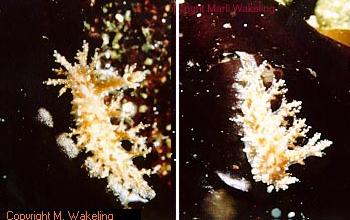
I think this is a Dendronotus frondosus, but it was so tiny, it was difficult to determine. There were many of these in the spring in Howe Sound and at Orlabar Point, British Columbia, Canada. They were usually on hydroids.
Marli Wakeling
scubamarli@excite.com
Wakeling, M., 2000 (Oct 30) Dendronotus frondosus from Canada. [Message in] Sea Slug Forum. Australian Museum, Sydney. Available from http://www.seaslugforum.net/find/3200Thanks Marli,
Could you include some indication of size with your interesting photos? To some of us 'tiny' would suggest 2-3mm while to a Sea Hare enthusiast 'tiny' would mean 5-10cm!
Best wishes,
Bill Rudman.
Dendronotus dalli from British Columbia
October 27, 2000
From: Marli Wakeling
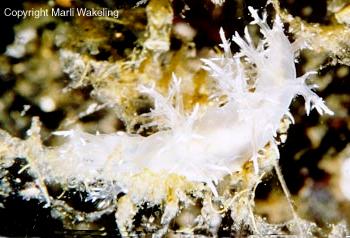
Dear Bill,
This is a particularly tiny specimen, about 7.5 mm in length. It's cerata are more finely branched than Dendronotus diversicolor, and is usually smaller. It is not as common either. This is from the Sechelt Penninsula in British Columbia, Canada.
Marli Wakeling
scubamarli@excite.com
Wakeling, M., 2000 (Oct 27) Dendronotus dalli from British Columbia. [Message in] Sea Slug Forum. Australian Museum, Sydney. Available from http://www.seaslugforum.net/find/3201Dear Marli,
This fits the description of Dendronotus diversicolor but I would be grateful for feedback from others about its identity.
Best wishes,
Bill Rudman.
Note: See my later message suggesting this is the white form of D. frondosus.
Rudman, W.B., 2000 (Oct 27). Comment on Dendronotus dalli from British Columbia by Marli Wakeling. [Message in] Sea Slug Forum. Australian Museum, Sydney. Available from http://www.seaslugforum.net/find/3201Feeding in Dendronotus frondosus
September 16, 2000
From: Caitlin Hammond
Hi,
I'm doing an honours thesis on the feeding of Dendronotus frondosus . I'm exploring whether or not they switch between thecate and athecate hydroids during their life cycle. If you know of any relevant articles or information, please contact me.
Caitlin Hammond
caitlin1410@yahoo.com
Hammond, C., 2000 (Sep 16) Feeding in Dendronotus frondosus. [Message in] Sea Slug Forum. Australian Museum, Sydney. Available from http://www.seaslugforum.net/find/3028Dear Caitlin,
If you have a look at the top of the Dendronotus frondosus page you will see I have referred to its change in diet. As a start, have a look at the Thompson & Brown (1984) reference.
I anyone has any more references to feeding studies on Dendronotus could they please let Caitlin and I know.
Best wishes,
Bill Rudman.
Dendronotus frondosus from the Netherlands
September 6, 1999
From: Peter H. van Bragt

Dear Bill,
Here is a photo of Dendronotus frondosus to add to the Netherlands' List.
Location: Zeelandbrug, Zierikzee, Oosterschelde, The Netherlands, 20 May 1999
With best regards
Peter H. van Bragt
Peter.vanBragt@ftn.hsbrabant.nl
van Bragt, P.H., 1999 (Sep 6) Dendronotus frondosus from the Netherlands. [Message in] Sea Slug Forum. Australian Museum, Sydney. Available from http://www.seaslugforum.net/find/1235Thanks Peter,
Bill Rudman.
Dendronotus frondosus from the Netherlands
September 1, 1999
From: René Lipmann
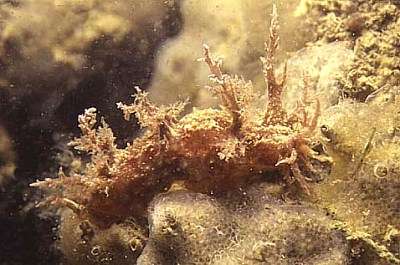
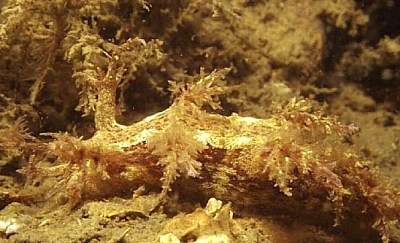
Bill,
I like to report you this nudi:
Dendronotus frondosus (Ascanius, 1774)
(In Dutch called 'boompjesslak)
We found this Dendronotus frondosus on a small wreck. Location called Kats, Oosterschelde. Depth around 11 meters
René Lipmann
lipmann@bvd.nl
Lipmann, R., 1999 (Sep 1) Dendronotus frondosus from the Netherlands. [Message in] Sea Slug Forum. Australian Museum, Sydney. Available from http://www.seaslugforum.net/find/1269Thanks René,
I have one of Peter van Bragt's photos of Dendronotus, also from the Netherlands, at the top of this page. Is it possible to translate 'boompjesslak' into English?
Best wishes,
Bill Rudman.
Re: Dutch name for Dendronotus
September 1, 1999
From: René Lipmann
Dear Bill,
a translation of the Dutch name 'boompjesslak' into English is maybe 'treeslug'
But 'boompjes' means a little, or small tree, and slak = slug. So maybe you have a better suggestion?
Groeten,
René Lipmann
Diveteam Manta,
Amsterdam
lipmann@bvd.nl
Lipmann, R., 1999 (Sep 1) Re: Dutch name for Dendronotus. [Message in] Sea Slug Forum. Australian Museum, Sydney. Available from http://www.seaslugforum.net/find/1277Dear René,
Thanks for the explanation. I'm not a great fan of encouraging the use of common names as they become very confusing. 'Tree-slug' for example might suggest it lived in trees.
I had a feeling that we had a query sometime ago about what is a 'bushy-backed slug', which would be an appropriate translation of boompjesslak. Using the very useful Search the Forum button [I typed bushy] I find that we did have some messages showing that in the USA 'bushy-backed sea slug' is used for species of Dendronotus.
Best wishes,
Bill Rudman
